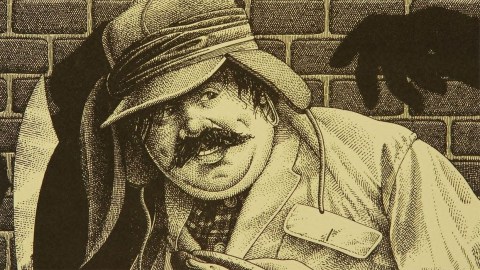6 literary masterpieces that almost never saw the light of day

- Even the most celebrated literary masterpieces often faced challenges before being published.
- These challenges included multiple rejections, difficulties finding publishers, and external pressures in the authors’ lives.
- From To Kill a Mockingbird to A Confederacy of Dunces, here are the stories of six great books that almost never got published.
As any writer will tell you, publishing something can be a nightmare. After working for ages on something you’ve grown attached to, you then have to send it out into the world. Often, you score nothing but rejection after rejection, and this happens not only to writers you’ve never heard about but also to the biggest names in literary history.
Here are six masterpieces of literature that were repeatedly rejected, hidden away, and even thrown out of windows before they reached bookshelves.
To Kill a Mockingbird by Harper Lee
To Kill A Mockingbird is the story of how an innocent man is charged and defended in court as told from the perspective of a young child. Since its publication in 1960, it has never been out of print, has been adapted for film and stage, and has faced numerous challenges over its themes and language.
After quitting her job as a clerk, Ms. Lee spent a year writing her first draft. This was made possible by donations from friends. The original draft, entitled “Go Set a Watchman” was described as “more a series of anecdotes than a fully conceived novel.” However, Lee’s publisher saw the potential in the manuscript and encouraged her to improve it. Over the next two and a half years, Lee worked to refine her masterpiece. Often frustrated, she once threw the manuscript out of her window into a snow bank before tearfully calling her editor.
When it was ready for print, expectations were low. It has since sold tens of millions of copies and has come to earn glowing reviews after a short period of difficulty.
In Search of Lost Time by Marcel Proust
Attempting to summarize Proust is so difficult that Monty Python made a sketch about it. Keeping that in mind, In Search of Lost Time is a mammoth text that tells the life story of an unnamed narrator as he grows up in late 19th-century and early 20th-century France. It spends a great deal of time on memory, especially involuntary memories prompted by the world around us.
The first volume of the work, Swann’s Way, was passed over by many leading publishers. French author and Nobel Prize winner Andre Gide advised one publisher against accepting the book after noticing a few errors while leafing through it. After these and several other rejections, Proust paid the publisher Grasset to produce the first volume of the novel. When the book was successful, Proust received a letter of apology from Gide, who called rejecting the book “….one of the most stinging and remorseful regrets of my life.”
Some of the publishing houses that had rejected volume one offered to produce the rest of his book. Proust stuck with Grasset. The book now enjoys universal critical acclaim. After reading it, British Novelist Virginia Wolf famously lamented, “Oh, if I could write like that!”
The Diary of a Young Girl by Anne Frank
Also known as “The Diary of Anne Frank,” this autobiographical work tells the true story of a Jewish family and four others hiding in a secret annex in occupied Amsterdam during WWII. It depicts the horrors of Fascism and the difficulties of growing up in a striking manner. The book is among the highest-selling non-fiction works of all time.
While Anne had rewritten parts of her diary in response to a radio announcement that dairies kept during the war would be noteworthy after the Allied victory, her father – the only person in the annex to survive the Holocaust – initially hesitated to publish it. Anne had also made statements about keeping her dairy private.
After combining elements from the two versions of the dairies – one edited for later publication and the other the original, unedited copy – to make a draft suitable for publication, Mr. Frank began submitting the text to publishers. The rejection letters began to pile up. However, it slowly drew attention, eventually attracting the support of historians who also began searching for a publisher.
After being rejected by several more Dutch printing houses, the historians wrote about the book in the Amsterdam newspaper Het Parool hoping to attract anyone willing to support their efforts. While this did secure them a publisher, even this one demanded edits and cuts before going to print. Nevertheless, the Dutch language version of the book was immediately well received.
The American publication of the novel was made possible by the famous Judith Jones. She pulled the French version out of a pile of texts rejected by other American publishers.
Animal Farm by George Orwell
Animal Farm is an allegorical satire about the Russian Revolution and the rise of Joseph Stalin. After overthrowing their human farmer, the animals of an English farm seek to create a utopia. Over time, their dream slowly erodes. The book has been highly praised since its release and is considered a masterpiece of satire.
Publishing the book proved to be extremely difficult. When Orwell submitted the manuscript to a company that employed T.S. Eliot, it was rejected by him personally. The famous poet suggested changes to how the Trotskyist viewpoint was covered and the exact nature of the story’s moral. Eliot also mentioned the difficulties of publishing a book critical of Russia at the time, which proved prophetic.
Several publishers refused to consider the book as it was deemed anti-Soviet and potentially damaging to the ongoing wartime alliance between the UK, US, and USSR. The publisher Johnathan Cape accepted the book but then turned it down after consulting with an official at the British Ministry of Information, who was later found to be a Soviet spy. A publisher who would take the book was found in 1945, but even that firm endured pressures against printing it.
On a completely unrelated note, Orwell’s next book centered on a man who worked in the censorship office of a totalitarian regime and decided what was printed and what was burned based on government prerogatives. Where he got the idea for this is surely lost to history.
Dune by Frank Herbert
A science fiction epic following the machinations of several governments, religious orders, and indigenous groups on the desert planet Arrakis. Dune is widely considered one of the greatest novels in the genre.
Initially published as a serial in Analog magazine, Herbert reworked the story for publication as a novel. Unfortunately, more than twenty publishers rejected him. While a few of these rejections acknowledged the book’s quality, one review noted, “I might be making the mistake of the decade,” none were willing to take it.
Sterling Lanier of the Chiton Book Company eventually discovered the book. While that publisher was best known for their collection of compatible repair manuals and trade magazines. It was not a best seller and Lanier was sacked for his efforts. Later sales and reviews would improve, however. Arthur C Clarke, the co-author of 2001: A Space Odyssey, said he knew “nothing comparable to it except for Lord of the Rings.” Carl Sagan also enjoyed the novel.
A Confederacy of Dunces by John Kennedy Toole
Rich with jokes and authentic portrayals of early-1960s New Orleans culture and dialects, this wending picaresque novel follows the slow-paced life of Ignatius J. Reilly, a self-styled scholar who lives with his mother and can’t hold down a job.
The book — which some consider a comic masterpiece — was written in the 1960s but wasn’t published until 1980. However, Toole never saw his book’s publication, having committed suicide in 1969 after A Confederacy of Dunces was rejected by Simon & Schuster and he began suffering from symptoms of paranoia and depression.
That the book was published at all is thanks largely to the efforts of Toole’s mother, Thelma Toole. After her son’s suicide, she tried to get the manuscript published, but she faced multiple rejections. Thelma eventually reached out to the renowned Southern writer Walker Percy, who was teaching at Loyola University in New Orleans at the time.
Initially skeptical, Percy was eventually captivated by the novel’s unique voice and humor. He recognized its literary value and played a significant role in getting the manuscript published. With Percy’s support, Louisiana State University Press published A Confederacy of Dunces in 1980, more than a decade after Toole’s death. The novel went on to win the Pulitzer Prize for Fiction in 1981.





